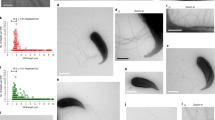Abstract
The bacterial flagellum is an appendage structure that provides a means for motility to promote survival in fluctuating environments. For the intracellular pathogen Salmonella enterica serovar Typhimurium to survive within macrophages, flagellar gene expression must be tightly regulated, and thus, is controlled at multiple levels, including DNA recombination, transcription, post-transcription, protein synthesis, and assembly within host cells. To understand the contribution of flagella to Salmonella pathogenesis within the host, it is critical to detect flagella production within macrophages via microscopy. In this paper, we describe two methods for detecting bacterial flagella by microscopy both in vitro and in vivo infection models.
Similar content being viewed by others
References
Brenner, S. and Horne, R.W. 1959. A negative staining method for high resolution electron microscopy of viruses. Biochim. Biophys. Acta34, 103–110.
Cattini, P.A. and Davies, H.G. 1984. Observations on the kinetics of uranyl acetate and phosphotungstic acid staining of chromatin in thin sections for electron microscopy. Stain Technol.59, 291–304.
Chevance, F.F. and Hughes, K.T. 2008. Coordinating assembly of a bacterial macromolecular machine. Nat. Rev. Microbiol.6, 455–465.
Choi, E., Han, Y., Cho, Y.J., Nam, D., and Lee, E.J. 2017. A trans-acting leader RNA from a Salmonella virulence gene. Proc. Natl. Acad. Sci. USA114, 10232–10237.
Datsenko, K.A. and Wanner, B.L. 2000. One-step inactivation of chromosomal genes in Escherichia coli K-12 using PCR products. Proc. Natl. Acad. Sci. USA97, 6640–6645.
De Carlo, S. and Harris, J.R. 2011. Negative staining and cryo-negative staining of macromolecules and viruses for TEM. Micron42, 117–131.
de Vries, N., Zwaagstra, K.A., Huis in’t Veld, J.H., van Knapen, F., van Zijderveld, F.G., and Kusters, J.G. 1998. Production of monoclonal antibodies specific for the i and 1,2 flagellar antigens of Salmonella typhimurium and characterization of their respective epitopes. Appl. Environ. Microbiol.64, 5033–5038.
Drevets, D.A., Canono, B.P., Leenen, P.J., and Campbell, P.A. 1994. Gentamicin kills intracellular Listeria monocytogenes. Infect. Immun.62, 2222–2228.
Eriksson, S., Lucchini, S., Thompson, A., Rhen, M., and Hinton, J.C. 2003. Unravelling the biology of macrophage infection by gene expression profiling of intracellular Salmonella enterica. Mol. Microbiol.47, 103–118.
Garcia-del Portillo, F. 2001. Salmonella intracellular proliferation: where, when and how? Microbes Infect.3, 1305–1311.
Griffiths, G. 1993. Introduction to immunocytochemistry and historical background. In Fine structure immunocytochemistry, pp. 1–8. Springer Berlin Heidelberg, Berlin, Heidelberg, Germany.
Hautefort, I., Thompson, A., Eriksson-Ygberg, S., Parker, M.L., Lucchini, S., Danino, V., Bongaerts, R.J., Ahmad, N., Rhen, M., and Hinton, J.C. 2008. During infection of epithelial cells Salmonella enterica serovar Typhimurium undergoes a time-dependent transcriptional adaptation that results in simultaneous expression of three type 3 secretion systems. Cell. Microbiol.10, 958–984.
Hayat, M.A. 2000 Principles and techniques of electron microscopy: biological applications. Cambridge University Press, Cambridge, UK; New York.
Ikeda, J.S., Schmitt, C.K., Darnell, S.C., Watson, P.R., Bispham, J., Wallis, T.S., Weinstein, D.L., Metcalf, E.S., Adams, P., O’Connor, C.D., et al. 2001. Flagellar phase variation of Salmonella enterica serovar Typhimurium contributes to virulence in the murine typhoid infection model but does not influence Salmonella-induced enteropathogenesis. Infect. Immun.69, 3021–3030.
Kim, K.W., Lee, I.J., Hyun, J.W., Lee, Y.H., and Park, E.W. 2010. Different profiles of the negatively stained citrus canker bacterium Xanthomonas citri pv. citri depending on culture media and heavy metal stains. Plant Pathol. J.26, 90–92.
Knodler, L.A., Vallance, B.A., Celli, J., Winfree, S., Hansen, B., Montero, M., and Steele-Mortimer, O. 2010. Dissemination of invasive Salmonella via bacterial-induced extrusion of mucosal epithelia. Proc. Natl. Acad. Sci. USA107, 17733–17738.
Maloy, S.R. and Nunn, W.D. 1981. Selection for loss of tetracycline resistance by Escherichia coli. J. Bacteriol.145, 1110–1111.
Mandell, G.L. 1973. Interaction of intraleukocytic bacteria and antibiotics. J. Clin. Invest.52, 1673–1679.
Nanassy, O.Z. and Hughes, K.T. 1998. In vivo identification of intermediate stages of the DNA inversion reaction catalyzed by the Salmonella Hin recombinase. Genetics149, 1649–1663.
Ohi, M., Li, Y., Cheng, Y., and Walz, T. 2004. Negative staining and image classification — Powerful tools in modern electron microscopy. Biol. Proced Online6, 23–34.
Renault, T.T., Abraham, A.O., Bergmiller, T., Paradis, G., Rainville, S., Charpentier, E., Guet, C.C., Tu, Y., Namba, K., Keener, J.P., et al. 2017. Bacterial flagella grow through an injection-diffusion mechanism. eLife6, pii: e23136.
Robin Harris, J. and Horne, R.W. 1994. Negative staining: A brief assessment of current technical benefits, limitations and future possibilities. Micron25, 5–13.
Samatey, F.A., Imada, K., Nagashima, S., Vonderviszt, F., Kumasaka, T., Yamamoto, M., and Namba, K. 2001. Structure of the bacterial flagellar protofilament and implications for a switch for supercoiling. Nature410, 331–337.
Sano, G., Takada, Y., Goto, S., Maruyama, K., Shindo, Y., Oka, K., Matsui, H., and Matsuo, K. 2007. Flagella facilitate escape of Salmonella from oncotic macrophages. J. Bacteriol.189, 8224–8232.
Schmitt, C.K., Ikeda, J.S., Darnell, S.C., Watson, P.R., Bispham, J., Wallis, T.S., Weinstein, D.L., Metcalf, E.S., and O’Brien, A.D. 2001. Absence of all components of the flagellar export and synthesis machinery differentially alters virulence of Salmonella enterica serovar Typhimurium in models of typhoid fever, survival in macrophages, tissue culture invasiveness, and calf enterocolitis. Infect. Immun.69, 5619–5625.
Valdivia, R.H. and Falkow, S. 1996. Bacterial genetics by flow cytometry: rapid isolation of Salmonella typhimurium acid-inducible promoters by differential fluorescence induction. Mol. Microbiol.22, 367–378.
Acknowledgments
This work was supported by the Basic Science Research Program of the National Research Foundation of Korea (NRF) funded by the Ministry of Science, ICT & Future Planning (NRF-2019R1A2C2003460) and by grants from Korea University (K1823071 and K1821661) to EL.
Author information
Authors and Affiliations
Corresponding author
Ethics declarations
The authors declare no conflict of interest.
Rights and permissions
About this article
Cite this article
Han, Y., Lee, EJ. Detecting Salmonella Type II flagella production by transmission electron microscopy and immunocytochemistry. J Microbiol. 58, 245–251 (2020). https://doi.org/10.1007/s12275-020-9297-y
Received:
Revised:
Accepted:
Published:
Issue Date:
DOI: https://doi.org/10.1007/s12275-020-9297-y




